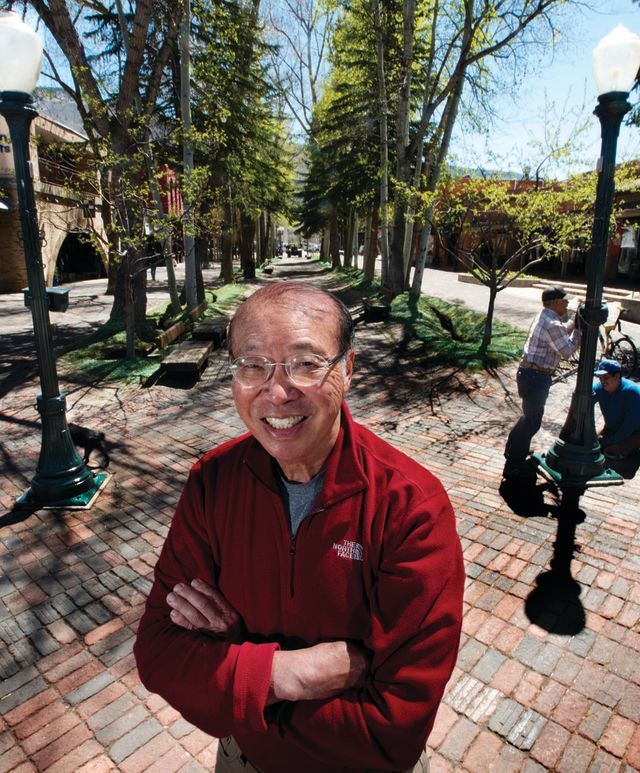A Q&A with Architect Richard Lai

Image: Karl Wolfgang
ASPEN SOJOURNER: What’s your origin story?
Richard Lai: I was born in Beijing in 1937, just before the Japanese invaded China. Right before Pearl Harbor, my father, who was in the diplomatic service, was posted to New Zealand. If Pearl Harbor had happened two months earlier, my family never would have gotten out.
AS: What do you remember of New Zealand?
RL: The first Americans I ever met were the Marines who protected New Zealand. They would give us American candy, Life Savers and lemon drops, things you couldn’t get during the war.
AS: You speak Mandarin, English, and Spanish. How’d you acquire Spanish?
RL: Right after the war, my father was transferred to British Columbia. It was the communist revolution in China, so his salary wasn’t coming through. We were destitute. My parents were thinking about opening a grocery store, but then he was transferred to Cuba. I got a scholarship to a prep school in Havana, and that school was so good that it got me into Princeton.
AS: Where you graduated with an MFA in architecture. How did you end up in Aspen?
RL: Every spring, I would write letters to architects looking for summer jobs. I spent two summers interning with an architect in New York City, another summer with an architect in Fort Lauderdale. Then during my last summer at Princeton, [architect] Sam Caudill offered me a job and I drove out to Aspen.
AS: What do you recall about that road trip?
RL: I was driving a 1951 Chevy. The guy who sold it to me was a Princeton professor, and it was a piece of junk. Going over Independence Pass, the radiator burst, and I had to fill it with water from a creek.
AS: That was in 1959. What was Aspen like back then?
RL: There were dirt roads, and when the wind would blow, there were great clouds of dust and you couldn’t see across the street. They didn’t have mail delivery back then, so every day at 10 or 11 o’clock, the mail would arrive, and the whole town would converge on the post office. It was like a high school locker room, and you’d meet everybody.
AS: After you returned to Princeton, you wrote your master’s thesis, proposing a pedestrian mall for Aspen.
RL: I looked at Santiago de Compostela in Spain, Oberammergau in Germany, and the Chapel of Notre Dame du Haut that Le Corbusier designed in Ronchamp, France. My thesis was that in all of those towns, people came in droves on pilgrimages. And people also made pilgrimages to Aspen, not just for skiing, but for the Aspen Music Festival; you could walk around town and out of windows you would hear people playing violin, practicing operatic scales. It was fantastic.
AS: You posited that Aspen’s pilgrims needed a place to gather. While working for Caudill, you chaired the design committee of an experiment that inspired today’s pedestrian mall.
RL: It was only for a week during the summer of 1961, but with the city’s cooperation, we closed off Galena to Mill and Cooper and blocked off the streets with boxes made from railroad ties that were filled with colored gravel. Fir trees were anchored to the ground with rebar like Christmas trees, and the Aspen Design Festival donated sculptures that were put all over the place. We brought in a platform for jazz and chamber music, and we opened up the water main so there was a stream running through the middle of it.
AS: That sounds magical!
RL: [Then–Aspen Times owner] Bil Dunaway wrote an editorial in the paper saying it was a success—and it was. That helped start the impetus for the permanent replacement.
AS: But you left Aspen in 1965, 11 years before the mall was built, and became a college professor teaching in Texas and Arizona. What made you recently retire to Aspen?
RL: I wanted to end my career where it started. But in a way, I never left. During my absence, for half a century, my family would come here on ski vacations and on summer vacations.
AS: What did you think the first time you walked the permanent mall?
RL: I was tickled pink! I remember my kids playing in the fountain. I don’t have many buildings that I’m remembered for because I was a teacher rather than a designer. But this is what I consider my greatest achievement. I wasn’t the designer, but it was my idea. I did that when I was in my 20s. Now I’m 80 years old.
AS: Any advice for the city as it begins its planned renovation of the mall?
RL: There are some practical things they have to do—like conforming to ADA requirements—but other than adding more interactive focal points like the fountain, I like it the way it is.
AS: What do you think about the city considering the mall for historic landmark designation?
RL: I’m actually astounded.... I had no idea that this would happen.
AS: Any last thoughts?
RL: History is the soul of mankind—it really is. I was on the planning commission when I was young. Now as an old man, I’m on the historic preservation committee here. That seems appropriate.













































